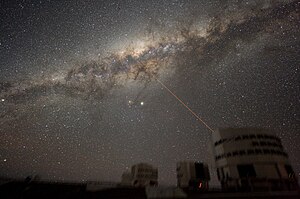From Wikipedia, the free encyclopedia

An image of the Milky Way's Galactic Center in the night sky above Paranal Observatory
|
The Milky Way is a barred spiral galaxy 100,000–120,000 light-years in diameter containing 100–400 billion stars. It may contain at least as many planets.[18][19] The Solar System is located within the disk, around 27,000 light-years from the Galactic Center, on the inner edge of a spiral-shaped concentration of gas and dust called the Orion Arm. The stars in the inner ≈10,000 light-years form a bulge and one or more bars. The very center is marked by an intense radio source named Sagittarius A* which is likely to be a supermassive black hole. Stars and gas throughout the Galaxy rotate about the center at approximately the same speed, which contradicts the laws of Keplerian dynamics. This indicates that much of the mass of the Milky Way does not emit or absorb electromagnetic radiation; this mass is known as dark matter.[20] The rotational period is about 200 million years at the position of the Sun.[9] The Galaxy as a whole is moving at a velocity of approximately 600 km per second with respect to extragalactic frames of reference. The oldest known star in the Galaxy is about 13.2 billion years old, nearly as old as the Universe. Surrounded by several smaller satellite galaxies, the Milky Way is part of the Local Group of galaxies, which forms a subcomponent of the Virgo Supercluster.
No comments:
Post a Comment